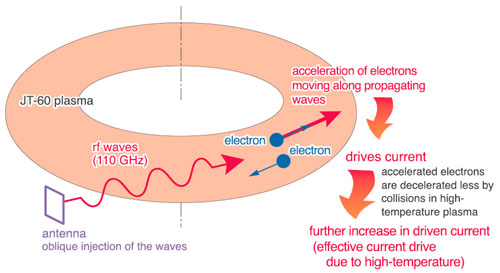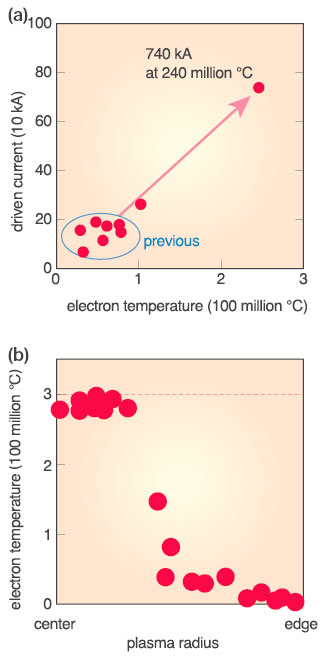It is necessary to drive the current in a tokamak device to confine high-pressure plasma. Since fusion reactors must have steady-state operation to stably produce electricity, a large current must be driven continuously. The conventional method of current drive uses the principle of a transformer; regarding plasma and external coils of the tokamak as the secondary and primary circuits of the transformer, respectively. Current in plasma is generated by the continuous increase of current in the external coils. It is hard to keep raising the external coil current, and a limit exists for continuously driving plasma current using this principle. In this study, current was driven using millimeter (rf) waves. The rf waves can continuously drive current, it is only necessary to continue the wave injection. Moreover, the rf waves can heat the plasma.
In the JT-60 tokamak, the ITER relevant electron temperature of 240 million degree Celsius was achieved using obliquely injected 2.3 MW rf waves (110 GHz). Since propagating rf waves selectively accelerate electrons that move in the wave direction, current (flow of electrons) is driven by the rf waves (Fig. 2-5). A current of 740 kA was generated in the plasma using this principle. The electrons accelerated by the rf waves are decelerated by collisions with ions and electrons in the plasma. Since these collisions, however, occur less frequently at higher temperature, these accelerated electrons produce more current. Thus, the driven current increases with electron temperature (Fig. 2-6 (a)). Electron temperatures of more than 200 million degree Celsius improved the current drive efficiency. The current was a world record for that driven by rf waves. The result demonstrated that the current drive by rf waves is effective at high electron temperatures, close to those in ITER.
Moreover, a much higher electron temperature of 300 million degree Celsius (a world record) was realized by the combined application of rf waves with another frequency (2 GHz) as shown in Fig. 2-6 (b).
|

